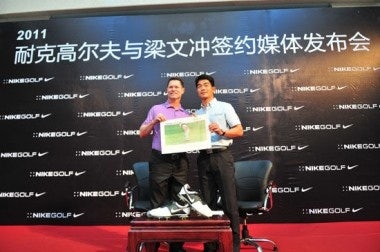Home-Grown Golf Equipment Brands, Increasingly Plush Golf Courses Woo Well-Heeled Chinese#

Wuhan's Tianwaitian Golf Club
It may still be very much a sport for the fortunate few in China, but golf continues to find new devotees among China's 1.3 billion-plus population. Since the country's first golf club was founded in 1984, in Zhongshan, Guangdong province, golf courses have proliferated throughout southeast and east China, and industry observers now estimate that there are between 300,000 and 5 million regular mainland Chinese golfers. Undeterred by astronomical membership fees, China's new wealthy have often become the country's new golfers as well, following their counterparts in Hong Kong, Japan and South Korea and often choosing the links as the preferred spot for business meetings and deal-making. Reflecting the popularity of the sport among the country's movers and shakers -- or those who aspire to be -- one worker at Tianwaitian Golf Club in Wuhan recently told Xinhua, “China now just has two types of rich people: those who play golf and those who don’t.”
With golf becoming ever more popular in China, despite the costs (and despite severe drought), as in every industry companies both domestic and international smell opportunity, and rightly so: China's nascent golfing industry is estimated at around 3 billion yuan (US$462 million), and is growing at an annual rate of 15 percent, according to China Daily. Still, as American, European and Japanese golf brands pour into the market, upstart Chinese brands enter the scene in droves, consumer education remains spotty, and the cost of golf remains prohibitively high, it will take quite some time for a deep golf culture to take root in China, and for true brand leaders to emerge. However, those who can afford to golf are now becoming increasingly sophisticated, a development that major equipment and apparel brands welcome.
According to China Daily, gone are the days when "fake foreign" golf brands foisted inferior products on a young and uneducated market. Now, spoiled for choice, Chinese golfers present a key demographic that can't be ignored:
At the moment, the Chinese golf equipment market is dominated by US brands Callaway, Titleist, TaylorMade and Nike as well as Japan's Mizuno and Honma. An average set of golf clubs costs about 15,000 yuan.
The golf equipment market is subdivided further with each brand having one or two competitive products. For example, Callaway's iron club and putt club are considered the best, Titleist's golf ball is ranked No 1 and experts say TaylorMade makes the best wooden golf club.
Chinese golf players appear to prefer US brands to those from Japan. Wu Ming, director of Shanghai Jiaotong University's school of golf management, said the popularity of US brands has a lot to do with their advertising as well as the popularity of the Professional Golf Association (PGA) tour among Chinese golfers. "In order to copy their golf heroes, Chinese golfers use US brands," said Wu.
Nike Golf recently signed an endorsement deal with Chinese pro golfer Liang Wen-Chong
"The preference for brand is also an indication of the improved skills of Chinese golf players," said Wang. According to her, most entry-level players prefer Mizuno and TaylorMade, while Callaway is more popular among high-level players, and Titleist is more used by professional players.
...
Liu believes the reason the Chinese prefer US brands has a lot to do with the successful golf culture in the US. "Although this game originated in Scotland, the US is the real golf Mecca. The US tour is the most successful in the world both in terms of attendance and economic returns. In addition, the US has the world's best golf courses and top-ranking golfers.
As a result, Japanese golf equipment brand Mizuno has found fierce competition in the China market over the past five years. Industrial analysts said the former second best seller in China is now lagging behind its US rivals, and only ranked fourth or fifth among all golf equipment brands in the country.
As the first foreign golf brand in China, Mizuno has witnessed growing demand for better service among Chinese customers. As a result, the company decided to provide tailor-made clubs.

As in the automotive, fashion and luxury markets, home-grown Chinese brands are looking to get their piece of the country's golf industry. However, rising labor and retail costs, a quality gap, and widespread preference for foreign golf brands among "serious" golfers could portend a coming industry shakeup. As China Daily notes, net profit margin is currently between only 5-8 percent, meaning any Chinese golf brand that hopes to make inroads at home or abroad will need to position itself firmly in the premium segment; no small task, considering the reason many Chinese golfers can rationalize the high price of their equipment is that it comes from countries like the US or Scotland that have strong golf cultures. As Liu Yongmao, founder of China's largest golf retailer, 100 Golf, put it, "It is possible (for Chinese golf brands to be successful) but very hard. It requires great capability, resolution and long-term commitment."
So the question remains: will these young brands put in the time and effort it takes to really build a foothold in their home market?